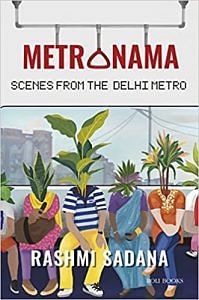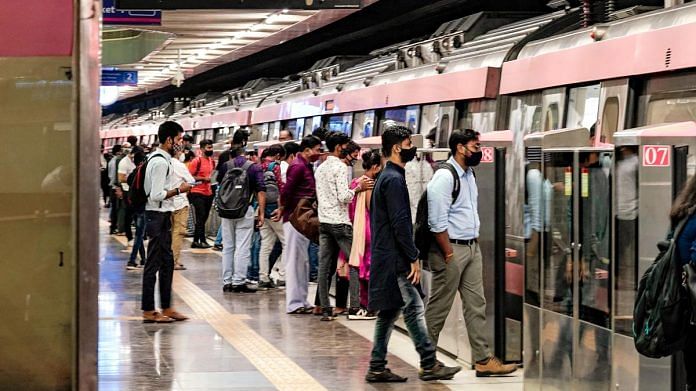At a meeting to save Delhi’s first Bus Rapid Transit, or BRT corridor, a few dozen architects, law students, and activists sit across an array of sofas and chairs. The scene seems strange to me at first. Everyone knew the battle against the city’s first BRT corridor was waged by the car-driving, upper-middle classes of South Delhi. When the Aam Aadmi Party won the chief ministership of Delhi in 2015, they soon announced the BRT would be scrapped. It is March 2015, and the BRT is set to be demolished, taken down, uninstalled. The South Delhi car constituency is relieved but also gleeful, in the “I-told-you-so” kind of way. Meanwhile, bus riders are not surprised something is being taken away from them; it had been too good to be true.
The day after the announcement to scrap the corridor, I see a posting on an urban listserv about a meeting to “save the BRT.” I show up at the appointed hour at a private ground-floor residence in the Hauz Khas area of South Delhi, just west of the actual corridor.
As I enter, one of the meeting organizers, Aashish, recognizes me and addresses me as “ma’am,” which was the norm when I taught him in a master’s programme at the IIT in Chennai more than five years before. It is a coincidence to see him here and a nice surprise. The room soon fills up. Aashish starts the meeting by holding up a dirty air filter, pointing to the large black circle of exhaust fumes formed, he tells us, over six days of Delhi pollution. “Mothers,” he says, “are effectively smoking.” The air we breathe from vehicular exhaust has become a notable equalizer in the city. It is also a problem and condition that will be passed down to younger generations, whether on the roads or in wombs.
Karthik, a doctoral student at MIT, thinks of the Save the BRT movement as class conflict, and says that the meeting is meant to figure out how to organize the bus riders who are benefiting from the corridor. People share ideas about getting on buses and talking to riders, getting them to volunteer, but also recording their experiences. There can’t be any “Metro bashing,” he adds. And we shouldn’t enter the design debate either, which was about where the bus stop islands should go or should have gone. The BRT didn’t fail because of faulty design, but because the infrastructure was not managed properly; it was doomed to fail. Even the Central Road Research Institute brought out reports criticizing BRT. “But they like to make roads for private vehicles,” someone says, “they value mobility rather than accessibility.” This movement, by contrast, was to focus on the users of the corridor (who benefitted most from it), the redistribution of road space (social equity), and air pollution (health and safety for all).
Ruchi makes a presentation to the group; she had worked with architect Sandeep Gandhi to design the BRT. She speaks with passion and precision about transportation. For her and the design team, the BRT is about democracy on the roads, modal share, and road design based on numbers served. Cyclists alone, she says, equal the same number as car users but take up a fifth of the space. The issue is about space, but it is also about technology and the politics of speed. Whose mode of conveyance gets privileged? Who gets to take up more space and move faster through the city? BRT is revolutionary because it essentially gives the bus rider the right of way. Ruchi reminds the group that Sheila Dikshit, the then Delhi chief minister supported BRT initially and was very much behind it, but that “she didn’t get the project” and turned tables in the election year.
Also Read: Why Delhi Metro carries far fewer riders than almost any other city’s system worldwide
When the meeting ends, I leave and walk toward the main road, looking for an auto rickshaw. It is eight-thirty at night and the colony is still busy, guys on motorcycles stopping to get paan or cigarettes, people walking by, also looking for autos or just going somewhere within the colony. I still can’t find an auto by the time I reach the busy Aurobindo Marg, a multilane thoroughfare that would be intimidating to cross. I wait as auto after auto passes by, most already filled with passengers. The few that slow down and stop don’t want to take me to where I want to go. I walk back toward the colony; a guy passes me and makes kissing noises. He is more annoying than threatening but makes me aware of the growing darkness of the night. The nearest Metro station is a good walk away and the wrong line for me anyway. Out on the road, in the dark, I feel like I am floating in a sea of car headlights and men, all men, I realize, passing me by. Soon I get picked up by two people from the meeting who see me from their car. Ruchi is driving and offers to drop me home. We, along with Nilesh, who was also at the meeting, talk about the difficulty of the campaign. The problem is with the public outreach, Ruchi says, which the Metro has in spades from all the English-language media. “If the Metro has some new signage, there’s an article about it in the Times of India,” she adds with sarcasm. The Metro remains the city’s darling, whereas even the police were against the BRT. They just want traffic to move, they don’t want jams of any kind, and they certainly were not issuing challans to any car owners for being in the wrong lane. As for the meeting, Nilesh points to the inherent problem of group interests and social action: “Probably half the people at the meeting drive cars and do so in the bus lane of the BRT.”
The Bus Rapid Transit corridor was dismantled by the Delhi government in 2016, after having been deemed a failure.

This excerpt from ‘Metronama: Scenes from the Delhi metro’ by Rashmi Sadana has been published with permission from Roli Books.



